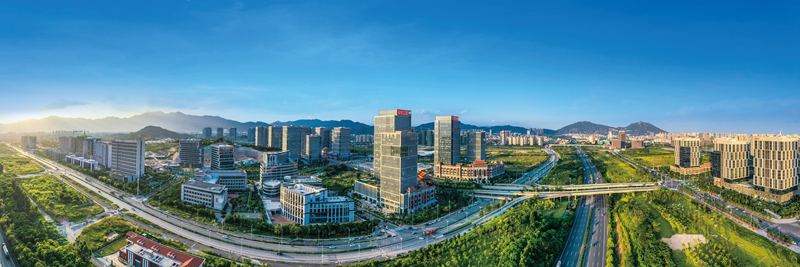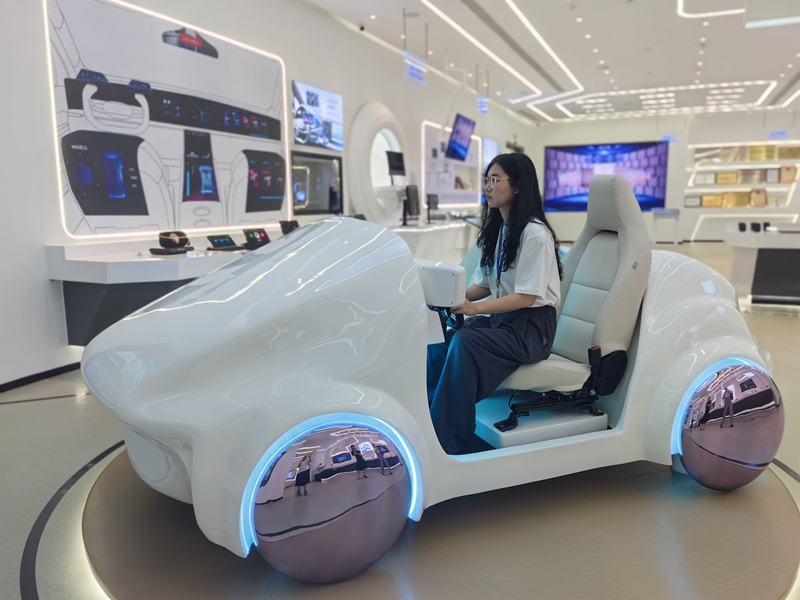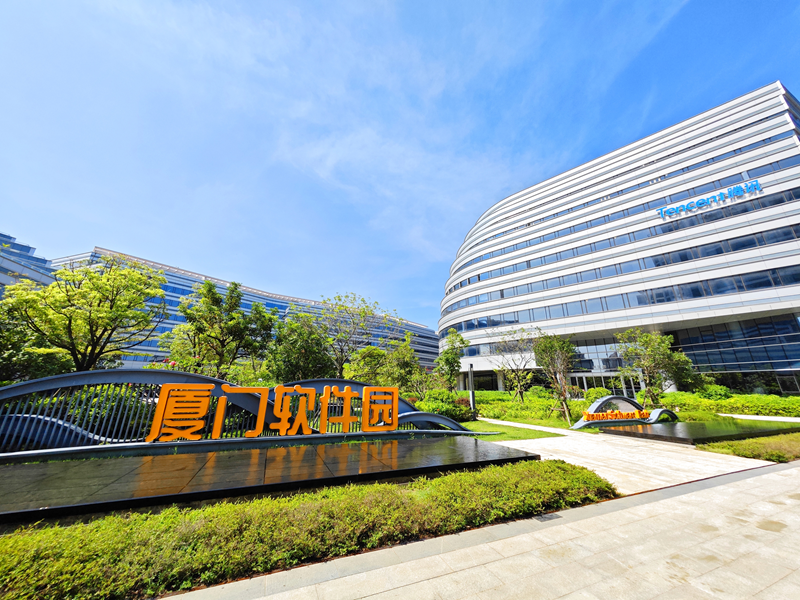
An aerial view of the third phase of Xiamen Software Park, an arm of the Xiamen Torch Development Zone for High Technology Industries. CHINA DAILY
AI, internet platforms key elements in sparking economic growth
Xiamen Torch Development Zone for High Technology Industries is advancing integration of the digital and real economies by leveraging technologies like industrial internet platforms and artificial intelligence to transform traditional industries and provide new momentum for economic growth.
In the Torch (Xiang'an) Industrial Zone, an arm of the high-tech zone in Xiang'an district of Xiamen, Fujian province, intelligent factories have ramped up production.
A shining example is Tianma Display Technology, a subsidiary of Tianma Microelectronics in the Xiang'an zone, which has established its factory for production of active-matrix organic light-emitting diodes, or AMOLED, covering more than 80 hectares.
"Xiamen is the fertile ground and hot spot for Tianma's development. Since settling in the torch zone in 2011, our cumulative industrial scale in Xiamen has exceeded 100 billion yuan ($13.94 billion)," said Wang Lei, executive vice-president of Tianma Microelectronics and general manager of Tianma Display.
"Among them, the TM18 production line has a total investment of 48 billion yuan, making it the highest single investment high-tech project in Xiamen to date," Wang added.
In the intelligent factory, production is almost completely unmanned. More than 600 processes in the panel plant are almost completely digitalized; engineers only need to manage remotely through a monitoring system, according to Wang.
On the production line, robotic arms operate with surgical precision while magnetic levitation carts transport glass along the tracks, showcasing scenes of a "factory of the future".
As a key business under the Aviation Industry Corporation of China, Tianma Microelectronics has established five production lines in Xiamen. Among them, the TM16 plant, which previously led the production of LCD screens for smartphones, is now transitioning to the automotive field and covers mainstream vehicles, maintaining the global top market share for the past several years. The TM18 production line, which achieved mass production and delivery of low-temperature polycrystalline oxide and foldable screen products by the end of 2023, is currently supplying flexible AMOLED foldable screens with orders continuing to rise.
"This is the next-generation display technology, also known as the 'hexagonal warrior' of the display family. It boasts advantages such as high brightness, long life span and low power consumption," said Wang while introducing the company's product prototype MicroLED.
"However, no production lines globally have achieved stable mass production yet, with the main challenge being the yield barriers associated with mass transfer," Wang said.
Noting Tianma has invested 1.1 billion yuan to build a pilot production line, Wang added: "We have achieved full-process integration and are currently focusing on improving production yield and efficiency, aiming to be the first to achieve small-scale mass production.
"Traditional display LED sizes typically range from a few hundred micrometers to millimeters, but MicroLED technology has now achieved sizes around 20 micrometers, roughly one-tenth the diameter of a human hair, with potential for further breakthroughs in the future. If this technology reaches mass production, it could revolutionize the display industry and is expected to see explosive growth in applications like automotive transparent screens and augmented reality glasses."
Meanwhile, Reconova, an information technology business in Xiamen Software Park of the high-tech zone, is utilizing its AI vision technology to serve the civil aviation industry.
In the company's exhibition hall, a real-time screen displays the T3B terminal at Chongqing Jiangbei International Airport, the largest single satellite terminal in the world by floor area, where Reconova's AI vision intelligence boarding gate operates.
The AI boarding gate integrates visual perception and multimodal recognition technology to identify behaviors such as passenger tailgating, impersonation boarding and carrying oversized or multiple pieces of luggage. It also takes into account special situations like passengers holding infants, accompanying young children or using wheelchairs, adjusting the navigation system in real time. This helps enhance boarding efficiency and reduce the workload of ground service staff, according to Zhan Hongmei, vice-president of Reconova.
The company has applied vision intelligence technology to all stages of the airport, from check-in to security screening and from waiting areas to boarding, with more breakthroughs expected in the overseas market this year. As a participant in the establishment of national standards for AI, Reconova has led the development of nearly 30 national standards. Of those, 16 covering core areas of vision intelligence technology have been published and implemented.
In the company's cargo scenario exhibition area, a vehicle-mounted device equipped with multiple sensors simulates driving behavior detection. "The system can capture dangerous behaviors in real time, such as driver fatigue and distracted downward glances, effectively reducing the rate of traffic accidents," Zhan said.
The system serves commercial fleet operators and collaborates with insurance companies. Through data analysis, it assesses driving behavior to help reduce commercial vehicle insurance claim rates.
Industry collaboration
To advance comprehensive implementation of digital transformation, the high-tech zone has adopted a collaborative model that includes industry-leading enterprises, service providers and small and medium-sized enterprises.
Xiamen Meisu Industry and Trade, an enterprise in the zone, has installed a screen system for management at its precision components workshop that displays real-time data on the flow and inventory of thousands of materials. "In the past, keeping records manually made finding a part like searching for a needle in a haystack. Now, everything is accomplished by simply scanning a code," said Xu Bingyue, general manager of Meisu.
The system, which has boosted Meisu's efficiency by 30 percent in material management, comes from the support of industry-leading enterprise AUO. A leader in the flat panel display industry, AUO has used its digitalization expertise to develop tailored solutions for companies like Meisu.
The high-tech zone has adopted a collaborative model, combining industry-leading enterprises, service providers and SMEs to foster digital transformation and reshape the industrial landscape. Data show that, more than 80 percent of industrial enterprises in the zone have entered the digital transformation stage, resulting in the cultivation of three national-level outstanding factories, five national-level intelligent manufacturing demonstration factory units and four national-level excellent intelligent manufacturing scenarios.
One of the representative businesses in the high-tech zone's collaboration practice is Yamaha Motor Solutions, a Japanese-invested company, which has been in Xiamen for 30 years. From serving its parent company, Yamaha Motor, to empowering the bathroom and mechanical equipment industries, its flexible production system has reduced the delivery cycle of customized products from 45 days to 21 days, setting a new industry benchmark. The company's business extends to automotive and motorcycle parts, automotive electronics and equipment manufacturing industries in the Yangtze River Delta region.
Meanwhile, the AI industry empowerment center under Baidu's deep-learning framework PaddlePaddle in the high-tech zone has collaborated with nearly 300 companies and incubated more than 20 industrial products. One notable example is the customized AI vision inspection solution for Ampace Technology, which increased the detection rate of battery defects to 99.9 percent, reducing losses by more than 10 million yuan annually.
Tianma has likewise partnered with the high-tech zone to form a dedicated investment team, focusing on attracting upstream supporting enterprises. By employing a model combining localization and joint development, it aims to improve the efficiency of the industry chain collaboration.
The highly customized nature of the display industry necessitates establishment of in-depth cooperation mechanisms with upstream partners, Wang said, noting that on one hand, achieving flexible delivery through proximity production allows suppliers to be located nearby for rapid order response; on the other hand, for cutting-edge technologies like MicroLED, joint development must begin from the research and development stage.
For example, Tianma collaborates with flexible circuit board manufacturer Honflex to develop high-end APC circuit boards, shortening the mass production cycle by jointly validating technical parameters, Wang added.
Policy support
From large model creation and AI algorithm optimization of games to the new generation of truth verification engines, digital industries in the Xiamen Software Park have seen burgeoning development thanks to the policy support from the hightech zone.
Covering nearly 15 square kilometers, the software park is home to 22,000 businesses, with more than 7,000 new companies joining in 2024. The park has formed five major industrial clusters, including big data, AI and gaming and animation.
By visiting companies such as Shenhao Soft and CurrentCAD, officials from the high-tech zone became aware that industrial software companies faced a lack of policy support. In response, they introduced specific innovative incentive clauses for industrial software. Companies with annual revenue exceeding 2 million yuan and an industrial software business ratio of over 50 percent are rewarded with 0.5 percent of their comprehensive benefits, with a maximum individual reward of up to 1 million yuan.
Since the policy was introduced, several industrial software companies have applied for it, and the first batch of rewards will be distributed this year. "Business growth requires sunlight and rain; our goal is to cultivate the most fertile soil," said a member of the high-tech zone's administrative committee.
In December 2024, the high-tech zone issued a guideline on several measures for further promoting high-quality development of the digital economy, stating that for AI companies with revenue exceeding 10 million yuan for the first time, a reward of 300,000 yuan will be granted; additionally, support will be provided for the construction of AI industrial parks, with a subsidy of up to 10 percent of the registered capital, capped at 2 million yuan.
In January, the zone released the plan for Fujian province (Xiamen) AI industrial park planning and construction. Supported by the construction of specialized platforms, industry funds, policy support and project introduction and cultivation, it focuses on creating a demonstration zone for innovative applications of AI, driving AI empowerment across various industries.
According to official data, the core digital economy industries in the high-tech zone currently have an average annual revenue growth of 15 percent, with more than 80 percent of industrial enterprises entering the digital transformation stage, and more than 200 companies related to AI.

A staff member of Tianma Display Technology showcases vehicle technology at the company's exhibition hall. CHINA DAILY

A staff member of Yamaha Motor Solutions operates a machine. CHINA DAILY

A view of the first phase of the Xiamen Software Park. CHINA DAILY

Copyright © General Office of Fujian Provincial People's Government
Website Identification Code 3500000049Registration Number: 15003084
All rights reserved. The content (including but not limited to text, photo, multimedia information, etc) published in this site belongs to fujian.gov.cn.
Without written authorization from fujian.gov.cn, such content shall not be republished or used in any form.